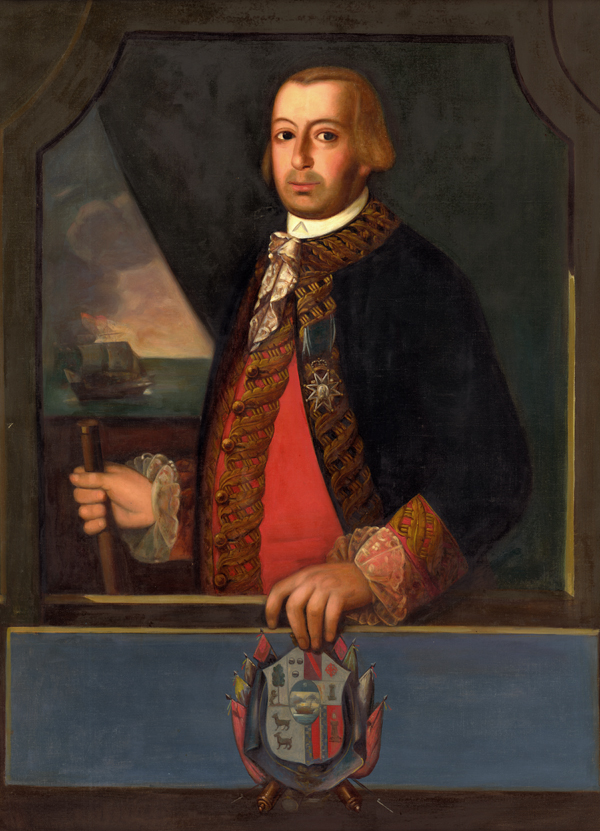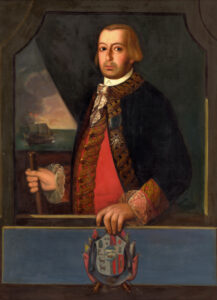Bernardo de Gálvez
Bernardo de Gálvez, the fourth governor of Spanish Louisiana, is best known for leading Louisiana militia troops against the British during the American Revolution.
This entry is 6th Grade level View Full Entry

Louisiana State Museum
Portrait of Bernardo de Gálvez.
Bernardo de Gálvez, the fourth governor of Spanish Louisiana, is best known for leading Louisiana militia troops against the British during the American Revolution. For his military success, especially in defeating the British at Mobile and Pensacola, King Charles III promoted Gálvez to lieutenant general, named him governor of West Florida and Louisiana, and made him a count.
What was Gálvez’s early life and career like?
Born on July 23, 1746, in the province of Málaga, Spain, the young Bernardo followed in the footsteps of many family members by training for a military career. Prior to arriving in Louisiana, Gálvez served as a lieutenant in Spain’s war with Portugal and as a captain in the Regiment of Corunna. He joined his uncle on a trip to New Spain in 1768, where he assumed command of expeditions against Apache people in the areas of Nueva Vizcaya and Sonora in what is now Mexico. He left New Spain in 1772, studied military science in France for several years, served with Alejandro O’Reilly in a failed attack against Ottoman forces in Algiers in North Africa, and accepted a commission as colonel of a regiment bound for Louisiana in 1776.
Soon after his arrival in Louisiana, the Spanish Crown issued a royal order on September 19, 1776, instructing Gálvez to replace Luis de Unzaga y Amezaga as Louisiana’s governor.
What actions did Gálvez take as governor of Louisiana?
Gálvez became governor at the age of thirty-one on January 1, 1777. That same year he married Félicité de St. Maxent d’Estréhan, a native of Louisiana and the widow of Jean Baptiste Honoré d’Estréhan. Gálvez and his wife had one son and two daughters. Census data collected around this time indicates that Louisiana was home to 8,381 white people, 273 free people of mixed African and European ancestry, 263 free people of African ancestry, 545 enslaved people of mixed African and European ancestry, and 8,464 enslaved people of African ancestry. The colony was also home to a sizable Native population, but Spanish census records excluded American Indians from the count. The new governor was quick to enforce anti-smuggling laws against the British and encourage new legislation that allowed Louisiana colonists to trade with France and the French colonies. He also oversaw Spain’s plan to encourage European immigration and the importation of enslaved Africans to Louisiana to spur economic growth.
By 1779 1,582 immigrants from the Canary Islands, now known as Isleños, had made their home along the Mississippi River, in communities stretching from New Orleans to Baton Rouge. A small number of English and American refugees affected by the ongoing war between the United States and Great Britain settled where the Amite River and Bayou Manchac meet, naming the site Galveztown. An additional five hundred immigrants from Málaga, Spain, settled in what would become New Iberia in 1779.
During the American Revolution Gálvez acted against British interests in the Mississippi Valley and Gulf of Mexico. Instructed by the Spanish Crown to aid the American cause, Gálvez provided military leaders like George Washington, George Rogers Clark, and James Willing with military supplies. He blocked the British from accessing the port of New Orleans and freely navigating the Mississippi River. He corresponded with American political leaders like Patrick Henry, Thomas Jefferson, Charles Henry Lee, George Gibson, and Oliver Pollock, and went to great lengths to reinforce Louisiana’s military personnel and fortifications.
When Spain formally declared war against Great Britain on June 21, 1779, Gálvez received orders “to direct all our efforts … to drive the British forces out of Pensacola, Mobile, and the other posts they occupy on the Mississippi.” With assistance from Juan Antonio Gayarré, Gálvez planned a series of military expeditions against nearby British posts. He led successful attacks against the British at Manchac, Baton Rouge, and Natchez with forces that included people of French, Spanish, Acadian, African, Native American, Swiss, German, and Mexican descent. In 1780, with the British forces in the immediate vicinity of New Orleans greatly weakened, Gálvez led more than one thousand men against British fortifications at Mobile. The British commander at Mobile surrendered to Gálvez on March 14, 1780, after a siege that lasted more than a month and involved both land and naval operations. A year later, after negotiating for reinforcements with Spanish officials in Havana, Gálvez began another land-sea expedition against the British, this time aimed at the much more formidable Fort George at Pensacola. With more than seven thousand men under his command, Gálvez laid siege to Fort George in March and formally accepted British surrender on May 10, 1781. Gálvez left Louisiana three months later, in August 1781. He continued to fight for Spanish interests in the Bahamas and Jamaica. He died in Mexico from a fever on November 30, 1786.
